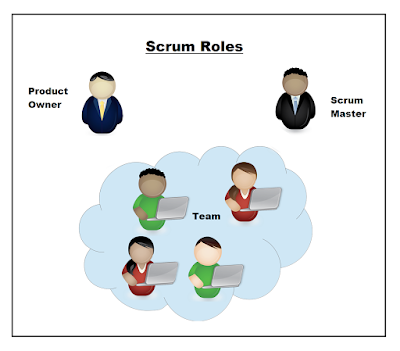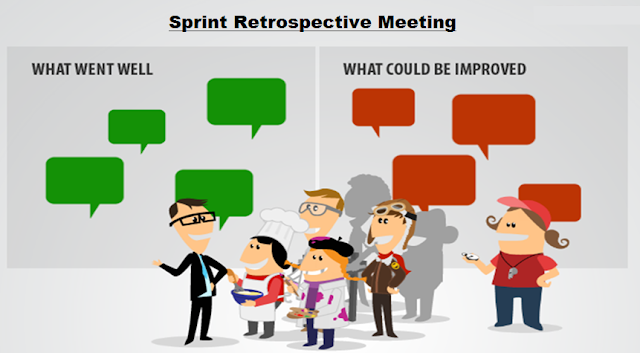The Agile -
Scrum Framework
Scrum is framework which is based on agile principles, a
framework that handle simple, complicated and complex software development.
Scrum is based on continuous improvement in product and
process.
Scrum deliver software frequently (value), it showcase the
hidden problems in systems development.
In scrum project move forward with series of iteration that
called Sprints. Each sprint size is typically two to four weeks long.
It is based on inspect and adaptive cycle. Produce product
incrementally and iteratively, thus reduce risk and enhance visibility.
Scrum
has simple roles, activities and artifacts.
Scrum
Roles:
Below are the roles in Scrum
1) Product Owner
2) Scrum Master
3) Team

1) Product Owner
- · Product Owner (PO) is client's representative
- · Define features of product
- · Decide release date and content
- · Priorities features according to market value
- · Be responsible for the profitability of product
- · Accept or reject work items
2) Scrum Master
- · Coach for scrum team
- · Enacting scrum values
- · Ensure team's productivity
- · Build winning team
- · Apply agile principles and make system effective.
3) Team
- · 5-9 Members team (Developer , Tester)
- · Self-organizing, High performance team
- · Build winning product
- · Work collaboratively and share responsibilities
- · Cross functional team.
Scrum
Activities:
- 1. Sprint Planning
- 2. Daily Scrum
- 3. Sprint Review
- 4. Sprint Retrospective
- 5. Product Backlog Refinement
1. Sprint Planning:
Goal: Team to plan and agree on
backlog items they can complete and confirm the tasks required to support
acceptance
Who: Scrum Team, Scrum Master,
Product owner
When: Beginning of the Sprint
Duration: 4 Hours for 2 weeks
sprint
How: In 2 parts.
Part 1: Define what needs to be
done
Part 2: How to achieve goal
Input: Priority,
Product Backlog, Acceptance criteria, Capacity
Output: Sprint goal, Sprint
Backlog, Tasks and their estimates, burn down chart, DOD,
Development plan/
Strategy.
Description:
·
Product owner present the backlog items in
priority order for review
·
Review and clarify user Backlog items/stories
·
Breakdown larger stories and each story into
task and acceptance criteria
·
Task are estimated in hours by team.
·
Developer and tester assigned to task
·
Process continue until all available hours are
used for the sprint.
·
Output of sprint planning is be Sprint backlog, Estimated
tasks etc.
2. Daily Scrum:
Goal: Plan for the day, Inspect and
Adapt daily towards reaching the sprint goal.
Who: Scrum Team, Scrum Master
When: Daily throughout the sprint
Duration: 15 minutes maximum
How: Team members form a group to
focus on daily plan, Discuss on issues faced yesterday.
Input: Current status, risks, and
done work
Output: Plan for the day, task to
work
Description:
·
Daily development Team standup for 15 minutes in
circle and talk only on three points
o
What I did since last daily scrum meeting?
o
What I am planning to work on today?
o
Impediments (Issue/blocker) if any?
·
Scrum master protect the team and facilitate for
being effective.
·
This give an opportunity to team to inspect and
adapt daily on the sprint goal.
3. Sprint Review:
Goal: Get feedback on product development. Inspect and adapt on the
product feature.
Who: Scrum Team, Scrum Master,
Product owner, Stakeholders
When: Last day of sprint
Duration: 2 hours for a 2 week
sprint.
How: Demonstrate the working
product to all.
Input: Sprint goal, 100% done
stories, acceptance criteria.
Output: Acceptance, feedback on
demonstrated stories.
Description:
·
During this meeting team demonstrate 100%
completed work.
·
Scrum master facilitate the environment.
·
In case any changes or new request, Product
owner (PO) note and updates the product backlog as required.
·
Product owner is final decision maker on
acceptance.
4. Sprint Retrospective:

Goal: To inspect and adapt to become more effective and efficient on
process, people, culture aspect.
Who: Scrum Team (anyone
participation is decided by the scrum team on invite basis only)
When: Last day of sprint
Duration: 2 hours for a 2 week
sprint.
How: Close room discussion of
observer pattern and desire results/improvements.
Input: Observation, issues, experience,
pattern in behavior, recommendations, feedback and information.
Output: List of
activities/steps/suggestions that help to make more effective and efficient.
Action items on the team
Description:
·
Participation in the discussion to inspect and
adapt as scrum team.
·
Scrum master play vital role in sprint
retrospective, Scrum master bring in the culture of openness, trust and respect
as people discuss the improvement areas, facilitate and focus on improvement
and changes that pointing fingers at others.
·
This is platform to scrum master to help team
resolve ineffectiveness in the systems
·
Inspect and Adapt: Try everything that
makes sense, reject things that didn’t work even after repeated trails. Shape
your culture, process and practice.
5. Product Backlog Refinement:
Goal: Keep product backlog items ready, uncertainty to certainty
Who: Scrum Team, Scrum master,
product owner
When: Continuous process, in
between the sprints.
Duration: 1-3 hours depending on
the team’s need.
How: priorities the items as per business
value. Add, remove, modify existing product backlog item to achieve release
scope/goal. Identify and discuss risks, dependencies and other uncertain items
in acceptance criteria.
Input: release strategy, priority,
product backlog, dependency/risk
Output: product backlog items 100% ready for future
sprint.
Description:
·
Product owner provide clarity on each product
backlog item (All uncertainty clarified into certainty )
·
Product owner Update product backlog. 100% be
present and involve all team members
·
Team understand, carefully listen to need of
product owner, understand the acceptance criteria. Help product owner to order
the backlog.
Scrum
Artifacts:
Below are the Artifacts in Scrum
1) Product Backlog
2) Sprint Backlog
3) Product Increment
1) Product Backlog
This is an ordered list
of ideas for the product, which can come from the product owner, team members,
or stakeholders. A description and estimate of effort complement each product backlog
item.
The product backlog is
ordered to maximize the value delivered by the Scrum team. The development
team’s work comes from the product backlog, and nowhere else. Every feature, enhancement,
bug fix, documentation requirement, every bit of work the team does comes from
a product backlog item.
The product backlog may
begin as a large or short list. Typically it begins short and becomes longer
and more defined as time goes on. Product backlog items slated for implementation
soon will be "refined," which means they will further clarified,
defined, and split into smaller chunks. Though the product owner is responsible
for maintaining the product backlog, the development team helps produce and
update it.
2) Sprint Backlog
The sprint backlog is
the list of refined product backlog items chosen for development in the current
sprint, together with the team's plan for accomplishing the work. It reflects
the team's forecast of what work can be completed. Once the sprint backlog is
established, the development team begins work on the new product increment.
3) Product Increment
Every sprint produces a
product increment, the most important Scrum artifact. A product Increment is
the "goal line" for each sprint and, at the end of the sprint, it
must:
·
Be of high enough quality to be given to users
·
Meet the Scrum team's current definition of done
·
Be acceptable to the product owner
Scrum
Information Radiators:
Task boards and
Burndown chart
Task boards:
·
Task boards allows transparency, display what is
the live status of the teams work and focus area
·
Simple task board has backlog , To-do, in
progress and done status
·
There are various format
·
Team design their best “Information Radiators”
that helps them in self-organizing
Burndown Chart:
·
For current sprint, it shows the total estimated work remaining for the
entire forecasted sprint backlog against time
·
Updated by team , regularly and continuously
·
Independent of the work, it represents total
remaining estimated time to market to achieve sprint goal









No comments:
Post a Comment